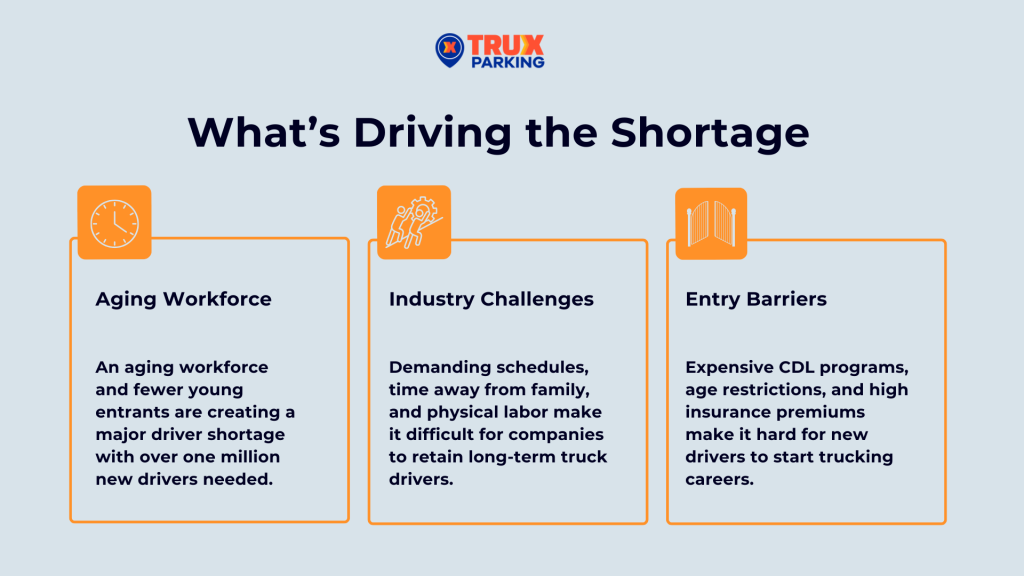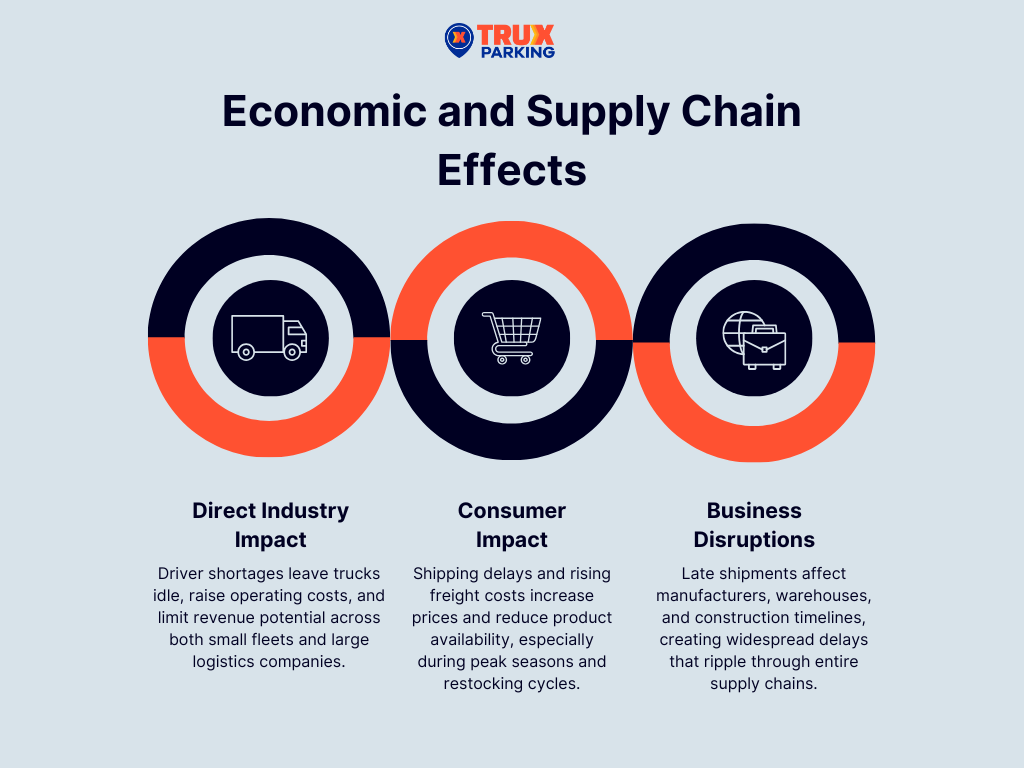The Short Answer: The U.S. trucking industry faces a significant truck driver shortage that leaves thousands of trucks sitting idle and creates substantial costs for the industry. This shortage stems from an aging workforce, challenging working conditions, and high barriers to entry, causing supply chain disruptions throughout the economy.
The American trucking industry stands at a turning point, grappling with a driver shortage that affects businesses and consumers alike. Thousands of trucks remain parked with no qualified drivers to operate them, leading to weekly industry losses in the millions. This shortage ripples through the entire United States economy, impacting everything from grocery deliveries to construction projects.
The following sections will cover the root causes of the trucker shortage, examine its economic impact, and look at how the transportation industry is adapting to these pressures. Understanding these factors is the first step toward finding workable solutions for this ongoing challenge.
Understanding the Root Causes
Demographics and Workforce Trends
The trucking industry faces significant workforce challenges tied to an aging workforce. The current driver population skews older than most other occupations, with fewer drivers entering the field at rates needed to address the growing truck driver shortage.
Key demographic challenges include:
- The average driver age is between 47-49 years old
- Declining interest from younger generations in truck driving careers
- Preference for jobs offering better work-life balance over the long-haul truckers’ lifestyle
- Growing gap between driver retirements and new driver recruitment
The American Trucking Association (ATA) announced that the industry will need around 1.2 million new drivers over the next decade to keep on track with growing demand and retirements. Many younger drivers view the transportation industry differently than previous generations, seeking careers that align with modern work expectations despite high demand for qualified drivers.
Industry Challenges
Life on the road presents ongoing difficulties that contribute to the driver shortage and make driver retention harder for trucking companies.
Major challenges drivers face include:
- Extended time away from families (days or weeks at a time)
- Long hours and irregular schedules that disrupt sleep patterns
- Physical demands beyond driving (loading, unloading, securing loads)
- Vehicle inspections are required in all weather conditions
- Missing important family events and daily connections
These demands can lead to fatigue and strain over time, raising safety concerns that both drivers and companies must address. The challenging working conditions contribute to high turnover rates and make it difficult for the trucking industry to attract potential drivers.
Entry Barriers
Several obstacles make it harder for potential drivers to start trucking careers, contributing to the shortage of truck drivers.
Primary barriers include:
- Commercial Driver’s License training programs require significant time and money investments
- Age restrictions limiting interstate driving to those 21 and older
- Insurance premiums often require several years of experience before coverage
- Financial challenges for candidates who struggle to afford training programs without assistance
This creates a gap between high school graduation and when many can start their careers. These barriers particularly affect independent contractors who must secure their own coverage, making it harder for trucking companies to hire new drivers and address the labor shortage.

Economic and Supply Chain Effects
Direct Industry Impact
The truck driver shortage creates major ripple effects across the transportation industry, affecting everything from small trucking companies to major industry leaders.
Key industry impacts include:
- Many trucks sit unused in lots across the United States
- Lost revenue opportunities affecting both large and small operations
- Increased operating costs as companies raise wages and offer bonuses to attract qualified drivers
- Higher shipping costs are passed through the supply chain
- Regional variations in shortage severity across different markets
Operating costs have increased significantly as the trucking industry competes for fewer drivers, with some areas experiencing more severe shortages than others. This has forced companies to rethink their driver retention strategies and compensation packages.
Consumer Impact
The trucker shortage’s effects reach far beyond the trucking industry itself. When goods can’t be moved efficiently, higher prices emerge as companies pass increased shipping costs to consumers. Delivery timelines have gotten longer and less predictable, especially during peak seasons. Some store shelves have gaps where products should be, as supply chain disruptions prevent normal restocking patterns.
Business Disruptions
Manufacturing companies face growing challenges as parts and materials arrive behind schedule, forcing adjustments to production plans. Warehouses and distribution centers struggle to maintain operational efficiency when shipments are delayed. Construction projects often pause or slow down while waiting for building materials that are stuck in transit. These disruptions create a domino effect; when one business faces delays, its customers and partners feel the far-reaching consequences too.
The interconnected nature of modern supply chains means that transportation problems quickly cascade across industries. Companies are adapting by building longer lead times into their planning, but the underlying shortage of truck drivers continues to create instability throughout the economy.

Current Industry Solutions
Compensation Changes
The trucking industry has made major adjustments to address the driver shortage and retain qualified drivers. Companies have significantly raised base pay rates, with many offering steady increases based on experience and safety standards. Sign-on bonuses have become standard practice, ranging from a few thousand dollars to five-figure sums for experienced truck drivers. Benefits packages now often include improved healthcare coverage, retirement plans, and better work-life balance through paid time off to match other industries.
Recruitment Initiatives
Trucking companies are expanding their recruitment efforts to attract potential drivers in new directions. Many have partnered with educational institutions to create training programs that help new drivers earn their Commercial Driver’s License (CDL). Military veteran programs have grown, taking advantage of veterans’ experience with large trucks and offering specific pathways into trucking careers. The American Trucking Association has supported many of these initiatives, helping coordinate industry-wide efforts to bring younger drivers into the transportation industry through targeted outreach programs and mentorship opportunities.
Technology Adoption
Technological advancement is making the trucking profession more appealing. Fleet management systems now help create more predictable schedules and routes, allowing drivers to plan their home time better. Mobile apps give truck drivers more control over their work lives, from finding parking spots to managing paperwork digitally. Companies are using scheduling software to improve operational efficiency at loading docks and optimize routes, making the job more attractive to younger generations who expect digital solutions in their work environment.

The Future of Autonomous Trucking
Self-driving trucks represent one of the most discussed potential solutions to the driver shortage crisis. Autonomous trucks and driverless trucks promise to address capacity issues by operating continuously without rest requirements that limit human drivers. The potential benefits include increased efficiency, reduced labor costs, and the ability to move goods 24/7 without concerns about driver availability.
However, the introduction of autonomous technology creates a paradox for the industry. While self-driving trucks could help meet immediate transportation needs, their development may actually discourage potential drivers from entering the profession. This uncertainty about job security could worsen the current shortage by deterring new recruits from the trucking industry.
The timeline for widespread driverless truck deployment remains unclear, with safety concerns and regulatory hurdles still presenting significant challenges. Until then, the industry must balance promoting trucking as a stable career path.
How TRUX is Supporting the Industry
The truck driver shortage represents one of the most pressing challenges facing American commerce today. From an aging workforce and high entry barriers to economic disruptions across industries, the shortage creates ripple effects that touch every consumer and business. While the industry adapts through higher compensation, new recruitment strategies, and technology adoption, the debate over autonomous vehicles adds another layer of complexity to workforce planning.
TRUX understands these challenges and works to support drivers and companies navigating this difficult landscape. By providing reliable solutions that reduce operational stress and improve efficiency, TRUX helps address some of the quality-of-life concerns that drive talented professionals away from the industry.
Secure, reliable parking shouldn’t add stress to your career. TRUX provides the security and convenience that drivers deserve, with strategically located facilities designed specifically for the trucking community.
Visit our secure facilities in:
Ready to simplify your parking experience? Reserve your spot with TRUX today and join thousands of professional drivers who prioritize safety and peace of mind in their parking choices.


